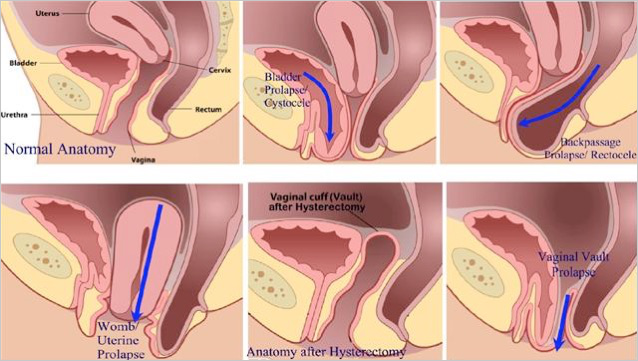A vaginal prolapse occurs when the support ligaments to the womb or vagina become too weak to work effectively.
Types of vaginal prolapse
Cystocoele
This is when the front wall of the vagina bulges because of a failure to the bladder support.
Rectocoele
This is when there is a bulge of the back wall of the vagina causing the rectum to bulge through.
Uterine prolapse
This is when the supports to the womb fail and it drops down through the vagina.
Vault prolapse
This is when the top of the vagina drops down after a hysterectomy.

For more Information download PDF : Read More
Causes of prolapse
Age and menopause
As we get older the elasticity of our tissues lessens which increases the risk of prolapse. After the menopause the low oestrogen levels also weaken the tissues and reduce the elasticity.
Pregnancy
This stresses the ligaments and supports of the vagina and womb. Caesareans do not prevent this, but, obviously a long, difficult or traumatic vaginal delivery increases the risk of developing prolapse and incontinence.
Genetics
Sometimes prolapse has an increased risk in families. Also there are certain conditions that increase the likelihood of prolapse eg Ehlers-Danlos syndrome., Marfan’s syndrome, joint hypermobility syndrome.
Obesity and chronic constipation
These obviously will have an influence on prolpase because of the increased pressure.
Pelvic tumours
Fibroids or ovarian cysts can also create extra pelvic pressure which can increase the risk of prolapse.
Type of work
A job involving heavy lifting will put extra stress on a prolpase.
Straining
There is an increased risk of prolapse in women with, for example a chronic cough, or chronic constipation.
Symptoms of prolapse
A prolpased vagina can cause the following symptoms:
- Dragging / heaviness in the vagina
- Fullness or pelvic pressure
- Something actually outside the vagina
- Painful sex
- Urinary symptoms: incontinence, urgency to pass urine, frequency of urination, incomplete bladder emptying, incontinence
- Bowel symptoms: constipation, having to support the back passage to empty
Prevention
Several things can reduce your risk of developing prolpase:
- Regular pelvic floor exercise,
- Maintaining a healthy weight
- Reducing constipation with a high fibre diet
- Stopping smoking
- Reducing heavy lifting

